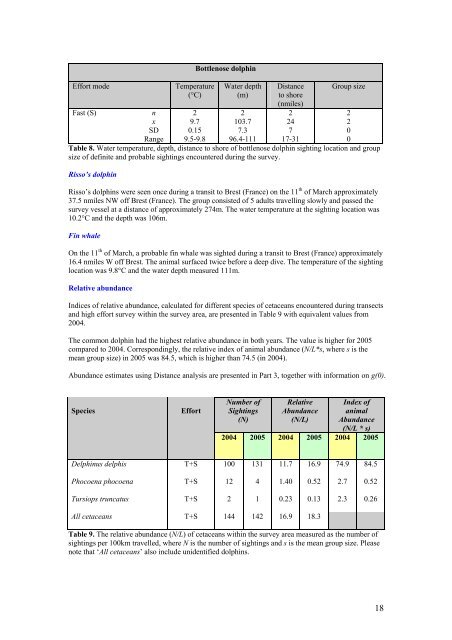Report of a cetacean survey in the Western Approaches of the ...
Report of a cetacean survey in the Western Approaches of the ...
Report of a cetacean survey in the Western Approaches of the ...
You also want an ePaper? Increase the reach of your titles
YUMPU automatically turns print PDFs into web optimized ePapers that Google loves.
Effort modeFast (S)nxSDRangeTemperature(°C)29.70.159.5-9.8Bottlenose dolph<strong>in</strong>Water depth(m)2103.77.396.4-111Distanceto shore(nmiles)2247Group size17-31Table 8. Water temperature, depth, distance to shore <strong>of</strong> bottlenose dolph<strong>in</strong> sight<strong>in</strong>g location and groupsize <strong>of</strong> def<strong>in</strong>ite and probable sight<strong>in</strong>gs encountered dur<strong>in</strong>g <strong>the</strong> <strong>survey</strong>.Risso’s dolph<strong>in</strong>Risso’s dolph<strong>in</strong>s were seen once dur<strong>in</strong>g a transit to Brest (France) on <strong>the</strong> 11 th <strong>of</strong> March approximately37.5 nmiles NW <strong>of</strong>f Brest (France). The group consisted <strong>of</strong> 5 adults travell<strong>in</strong>g slowly and passed <strong>the</strong><strong>survey</strong> vessel at a distance <strong>of</strong> approximately 274m. The water temperature at <strong>the</strong> sight<strong>in</strong>g location was10.2°C and <strong>the</strong> depth was 106m.F<strong>in</strong> whaleOn <strong>the</strong> 11 th <strong>of</strong> March, a probable f<strong>in</strong> whale was sighted dur<strong>in</strong>g a transit to Brest (France) approximately16.4 nmiles W <strong>of</strong>f Brest. The animal surfaced twice before a deep dive. The temperature <strong>of</strong> <strong>the</strong> sight<strong>in</strong>glocation was 9.8°C and <strong>the</strong> water depth measured 111m.Relative abundanceIndices <strong>of</strong> relative abundance, calculated for different species <strong>of</strong> <strong>cetacean</strong>s encountered dur<strong>in</strong>g transectsand high effort <strong>survey</strong> with<strong>in</strong> <strong>the</strong> <strong>survey</strong> area, are presented <strong>in</strong> Table 9 with equivalent values from2004.The common dolph<strong>in</strong> had <strong>the</strong> highest relative abundance <strong>in</strong> both years. The value is higher for 2005compared to 2004. Correspond<strong>in</strong>gly, <strong>the</strong> relative <strong>in</strong>dex <strong>of</strong> animal abundance (N/L*s, where s is <strong>the</strong>mean group size) <strong>in</strong> 2005 was 84.5, which is higher than 74.5 (<strong>in</strong> 2004).Abundance estimates us<strong>in</strong>g Distance analysis are presented <strong>in</strong> Part 3, toge<strong>the</strong>r with <strong>in</strong>formation on g(0).2200SpeciesEffortNumber <strong>of</strong>Sight<strong>in</strong>gs(N)RelativeAbundance(N/L)Index <strong>of</strong>animalAbundance(N/L * s)2004 2005 2004 2005 2004 2005Delph<strong>in</strong>us delphis T+S 100 131 11.7 16.9 74.9 84.5Phocoena phocoena T+S 12 4 1.40 0.52 2.7 0.52Tursiops truncatus T+S 2 1 0.23 0.13 2.3 0.26All <strong>cetacean</strong>s T+S 144 142 16.9 18.3Table 9. The relative abundance (N/L) <strong>of</strong> <strong>cetacean</strong>s with<strong>in</strong> <strong>the</strong> <strong>survey</strong> area measured as <strong>the</strong> number <strong>of</strong>sight<strong>in</strong>gs per 100km travelled, where N is <strong>the</strong> number <strong>of</strong> sight<strong>in</strong>gs and s is <strong>the</strong> mean group size. Pleasenote that ‘All <strong>cetacean</strong>s’ also <strong>in</strong>clude unidentified dolph<strong>in</strong>s.18
















